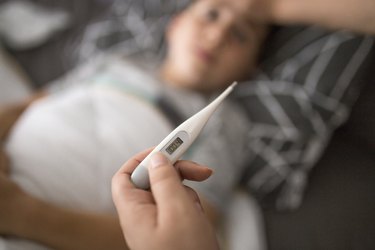
If your cheeks feel a little toasty, your breath is hot and you're coming down with the chills, chances are you may have a fever. But before you take a trip to the doctor, you can check by taking your temperature with a thermometer.
Digital thermometers, like those sold under the popular Vicks brand, are generally easy to use and give a quick temperature reading. These thermometers can be used in the mouth (oral) or armpit (axillary). Specially designed thermometers can be used in the rectum (rectal) for infants or very young children. No one measurement location is necessarily superior to another, but it's crucial that you take the proper steps to get an accurate reading.
Video of the Day
Video of the Day
Get tips on how to stay safe and sane during the novel coronavirus pandemic.
Handle Your Digital Thermometer Properly
First and most importantly, make sure you're being totally sanitary when taking your temperature. Wash your hands before handling the thermometer. Also, you should disinfect your thermometer both before and after use, according to the Mayo Clinic. If you measure your child's temperature with a rectal thermometer, you'll need to keep a separate thermometer for armpit or mouth use.
Depending on the area you're measuring, fever temperatures will vary slightly, per the Mayo Clinic. Generally, though, a temperature of 100 degrees Fahrenheit means you likely have a fever.
Temperatures Indicating You Have a Fever
- Oral: Temperature of 100°F or higher
- Axillary: Temperature of 99°F or higher
- Rectal: Temperature of 100.4°F or higher
How to Measure Your Temperature Orally
- With clean hands, use an alcohol swab to sanitize your digital thermometer, then turn it on.
- Place the tip of the thermometer under the tongue, moving it toward the back of the mouth.
- Close the mouth and keep the lips together until the device beeps or signals it has finished measuring.
- Remove the thermometer and look at the temperature reading on the screen to determine whether you have a fever.
- Using an alcohol swab, disinfect your thermometer, put it back into a clean case and wash your hands thoroughly.
Tip
To get an accurate reading with an oral thermometer, wait at least 15 minutes after eating or drinking.
How to Take an Axillary Temperature Measurement
- With clean hands, use an alcohol swab to sanitize your digital thermometer, then turn it on.
- Clean the armpit by wiping it gently with a towel.
- Place the thermometer under the armpit, making sure it touches only the skin, not clothing.
- Lower the arm down over the thermometer, pressing it into place.
- Keep the arm down until the thermometer beeps or signals it has finished measuring.
- Remove the thermometer and read the screen for the temperature.
- Using an alcohol swab, disinfect the thermometer and place it back into a clean case.
- Wash your hands.
How to Take a Rectal Temperature Measurement
- With clean hands, use an alcohol swab to sanitize your digital thermometer.
- Lubricate the tip of the thermometer with petroleum jelly and then turn it on.
- Gently place your baby or small child on his or her back, lifting thighs up.
- Carefully insert the thermometer only a half to 1 inch into the child's rectum.
- Hold the thermometer until it beeps or signifies the reading is complete.
- Remove the thermometer and read the screen for the temperature.
- Disinfect the thermometer, placing it back into a clean case. Wash your hands thoroughly
Tip
Never force a rectal thermometer past any resistance. And always make sure to wash your hands before and after any type of temperature measurement, especially a rectal reading, recommends the Mayo Clinic.
Treating a Fever
If your thermometer indicates a fever, make sure to take all necessary precautions by avoiding close contact with other people, getting enough rest and drinking plenty of fluids, recommends the Mayo Clinic.
If your fever is accompanied by symptoms like difficulty breathing, chest pain, severe headache, confusion or abdominal pain, seek medical care as soon as possible.
Was this article helpful?
150 Characters Max
0/150
Thank you for sharing!
Thank you for your feedback!
Is this an emergency? If you are experiencing serious medical symptoms, please see the National Library of Medicine’s list of signs you need emergency medical attention or call 911.